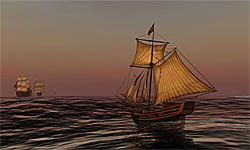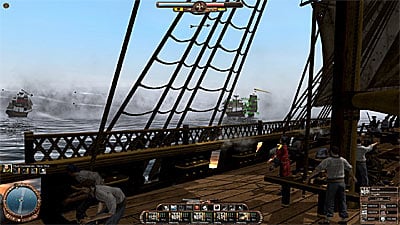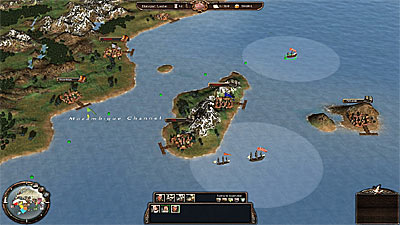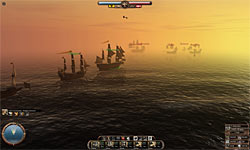Get Your Sea Legs Ready
Transporting various goods for sale along the high seas has always been a dangerous business, particularly back in the 17th century when marauding pirates and rival traders had few qualms about thrashing your vessel and making off with your loot. With the opportunity for great profit also comes the potential for catastrophic loss. Keeping that in mind, trying to firmly establish your foothold as a powerful force to be reckoned with, and beat out other competing trade empires that seek the very same wealth and glory, is as challenging as it sounds in East India Company.

There’s something almost freeing about being able to focus your empire building efforts solely on maintaining ports for trade and expanding your seaworthy fleet. So many strategy games – even those with seafaring elements – keep players shackled to managing troops and resources on land that it’s a welcome change to be concerned solely with the naval elements. Balancing your attention between being a shrewd businessperson with an eye for economic gain and becoming a formidable adversary when negotiations between competing factions inevitably break down is quite engaging, assuming you don’t fall prey to some of the game’s tough love.
Picking from one of eight nations – Britain, France, Italy, The Holy Roman Empire, The Netherlands, Portugal, Spain, and Sweden – you’ll start off the game’s 150-year Grand Campaign in the 1600s with a single beefed-up port, a meager bit of cash, and the desire to get your trade on. Several other modes offer minor variations on the main campaign. However, you’ll want to tackle the whole 150-year shebang for the most robust experience. The brunt of East India Company plays out across the costal areas on a large map of Europe and India, as you manage your budding fleet, plot courses, and send ships to and from their destinations in real-time. You can manually control individual ships and micromanage their purchases at each port, but it’s far less taxing to simply set automated trade routes for most of your vessels. Initially, ships can only be built at your home port, and you’ll only be able to afford several weaker vessels until you’ve accrued a reasonable monetary buffer. Extremely expensive larger trading ships and mightier battle-ready fleets are a necessity before long.

The game starts of at a slow burn as you begin tenuously forming shipping routes to import and export crucial goods needed to lay the groundwork for your trade empire and build your fleet. Buying locals goods at a reduced price, you’ll send the ships you’ve constructed on a trek to foreign lands to sell your wares and purchase more exotic cargo that fetches an impressive price at home. The market value of different goods ebbs and flows, and it becomes necessary to travel to specific ports in search of unique items to purchase. This is even more crucial as the game’s objectives kick in, requiring you to import specific volumes of certain goods and meet other goals within an allotted timeframe. The economic trade simulation element is suitably complex enough to satisfy strategy veterans, though it gets dry at times – not a great thing when it’s the crux of your entire operation.
Just when you start getting into a good rhythm of sending ships safely to and from various ports in India, the sanctions on piracy and combat are lifted. Being attacked by pirates or rivals in this early stage of your empire’s development can be devastating, since a single larger warship can easily take down a handful of your haulers and light combat vessels. The first few ships at your disposal, a mixture of weak cargo vessels with little attack power and slightly stronger fighting ships with fast speeds but little cargo space, quickly become inadequate. However, you have to pay ridiculously large sums of money just to unlock more powerful ships at your shipyard (assuming it’s upgraded to the max, which is expensive in and of itself), and stacking up to five ships in a single fleet for the necessary added security can quickly break the bank.

Poor trade decisions, debilitating random attacks, and failure to expand rapidly enough are among a number of other minor factors that can eventually send your trade business into a downward spiral that’s hard to recover from. Adding insult to injury, failure to meet the increasingly steep primary and secondary goals at any step of the way instantly ends the campaign. There’s a lot to juggle and constantly take into consideration to keep from sinking, and it’s not always much fun.

When you do find yourself in a position to be strong enough to push other rivals around, combat becomes an enticing prospect – in theory. Running into foes (and vice versa) brings up a handy pre-battle menu that shows the strength of both armies and the probability of success, but East India Company’s ship-to-ship warfare component is a double-edged sword. You can opt to quickly auto-resolve battles at the expense of the option to loot enemy cargo when you’re done, or taking a more hands-on approach to combat lets you manually control ships in gruelingly slow but pretty 3D encounters. Choosing the latter affords a beautiful close-up view of the carnage wrought between warring fleets, which contrasts sharply with the plain Jane-looking navigation map you’ll spend the bulk of your time on. In battle, you can control ships in a point-and-click real-time strategy mode or take direct command of a single vessel with the directional keys. Here, the special abilities of your ship captains can be put to good use, and you can also board ships to loot and plunder.
East India Company’s marriage of naval combat and deep economic trade simulation is a sound one, but it doesn’t take long for the honeymoon phase to wind down and the niggling little character flaws to come bubbling to the surface. Even the game’s most tedious moments will offer a good measure of entertainment for strategy gaming fans, though a number of issues may eventually have you questioning whether it’s worth sticking with in the long run.
RATING OUT OF 5 RATING DESCRIPTION 3.9 Graphics
The map is functional, but it’s the 3D battles that steal the show. 4.0 Control
A straightforward interface makes it easy to plot complex trade routes and engage in ship-to-ship warfare. 3.7 Music / Sound FX / Voice Acting
Solid music and sound effects. 3.6 Play Value
The potential for a lengthy amount of enjoyable seafaring trade and combat is there, provided some of the game’s issues don’t rub you the wrong way. 3.7 Overall Rating – Good
Not an average. See Rating legend above for a final score breakdown.
Game Features:
